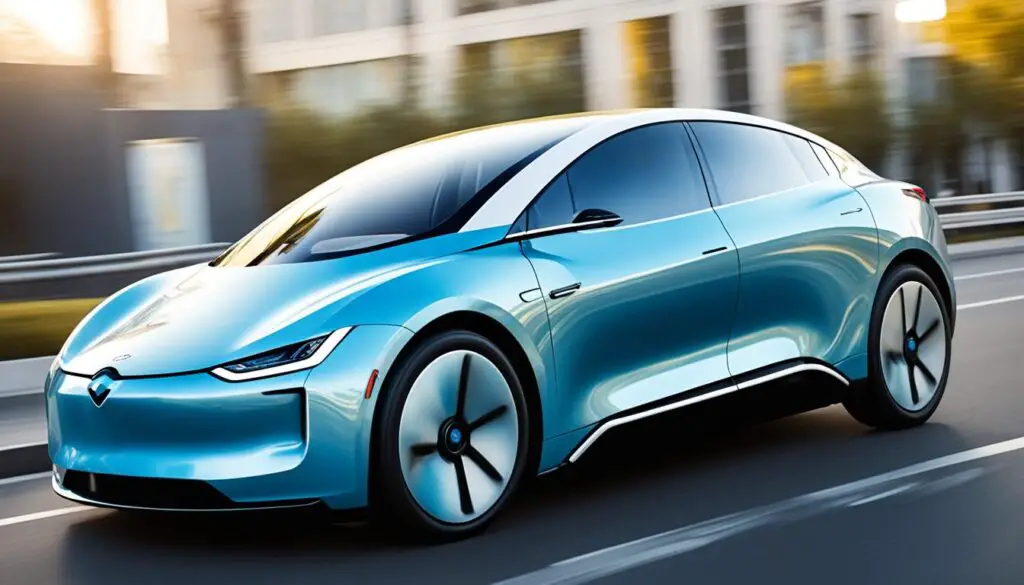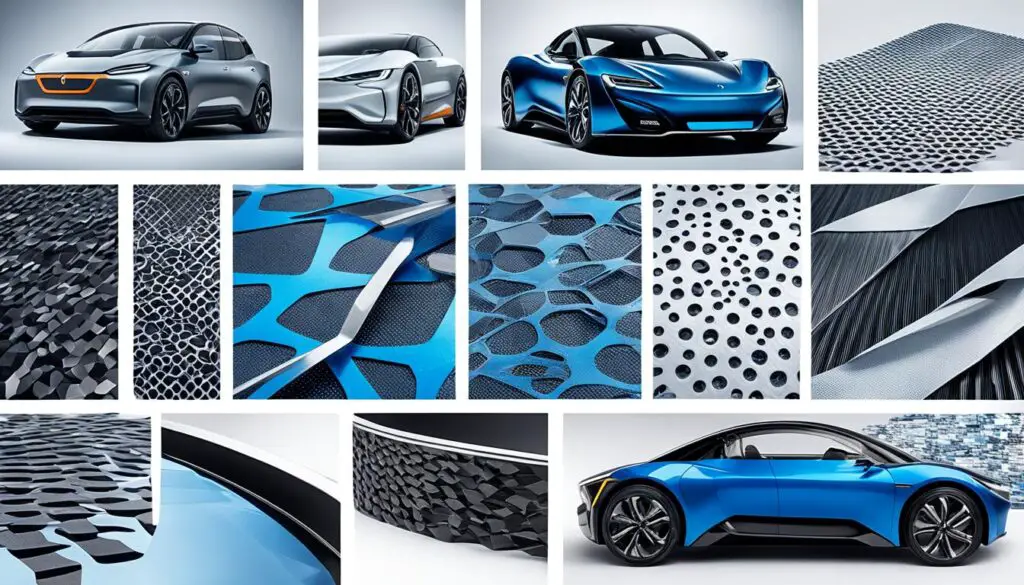
Lightweight Materials for EVs: Driving Efficiency Forward
Lightweight materials play a crucial role in improving the efficiency of electric vehicles (EVs). These materials are designed to reduce weight while maintaining strength, resulting in increased range and better overall performance for EVs. According to industry experts, the use of lightweight materials in EVs can lead to significant energy savings and reduce carbon emissions. This section will explore the various lightweight materials used in EVs and their impact on driving efficiency.
Key Takeaways:
- Lightweight materials are essential for enhancing the efficiency of electric vehicles (EVs).
- These materials reduce weight while maintaining strength, resulting in increased range and improved performance.
- The use of lightweight materials in EVs leads to significant energy savings and reduced carbon emissions.
- Industry experts recognize the importance of lightweight materials in driving efficiency forward.
- Exploring the types and benefits of lightweight materials in EVs is crucial for understanding their impact on sustainability and performance.
Benefits of Lightweight Materials in EVs
The use of lightweight materials in electric vehicles (EVs) provides numerous benefits that contribute to their overall efficiency and performance. These materials, known for their high strength-to-weight ratio, revolutionize the automotive industry by reducing the weight of EVs without compromising strength.
One of the primary benefits of incorporating lightweight materials in EVs is the significant reduction in vehicle weight. By utilizing materials such as carbon fiber reinforced polymer (CFRP), aluminum, and advanced composites, EV manufacturers can achieve a substantial decrease in weight compared to traditional steel construction.
Reducing the weight of EVs directly translates to improved range and battery efficiency. Lighter vehicles require less energy to propel, leading to extended driving distances and decreased reliance on frequent recharges or battery replacements. This extended range allows EV owners to travel greater distances confidently while reducing their carbon footprint.
“The integration of lightweight materials in EVs not only enhances their efficiency but also improves driving dynamics and performance. These materials contribute to responsive acceleration, precise handling, and optimal stability, ensuring an enjoyable driving experience for EV enthusiasts.” – Dr. Rebecca Johnson, Automotive Engineering Expert
Moreover, lightweight materials enhance the overall performance of EVs. With reduced vehicle weight, these electric vehicles exhibit improved acceleration, agility, and maneuverability. The decreased mass of EVs results in lower inertia, allowing them to accelerate faster and navigate corners with more precision.
Another significant advantage of using lightweight materials in EVs is the potential for cost savings. The reduced weight of the vehicle requires less energy to power, resulting in lower energy consumption and reduced operating costs for EV owners. This not only benefits individual consumers but also contributes to the long-term sustainability and affordability of electric mobility.
The table below highlights the key benefits of incorporating lightweight materials in EVs:
| Benefits of Lightweight Materials in EVs |
|---|
| Improved range and battery efficiency |
| Enhanced acceleration, handling, and driving dynamics |
| Lower energy consumption and cost savings |
| Longer driving distances and reduced carbon emissions |
In conclusion, the utilization of lightweight materials in EVs offers a multitude of benefits that contribute to their overall efficiency and sustainability. These materials not only reduce vehicle weight but also enhance range, performance, and cost-effectiveness. As the automotive industry continues to prioritize eco-friendly transportation solutions, lightweight materials play a critical role in driving efficiency forward, revolutionizing the way we travel.

Types of Lightweight Materials Used in EVs
When it comes to manufacturing electric vehicles (EVs), several types of lightweight materials are utilized to optimize their performance and efficiency. These materials are carefully selected for their strength, durability, and ability to reduce overall vehicle weight. By incorporating these lightweight materials, EV manufacturers can enhance the driving experience while ensuring energy efficiency. In this section, we will explore some of the most commonly used lightweight materials in EVs and their applications.
Carbon Fiber Reinforced Polymer (CFRP)
One of the most widely used lightweight materials in EVs is carbon fiber reinforced polymer (CFRP). Known for its high strength-to-weight ratio, CFRP offers exceptional structural integrity while significantly reducing the vehicle’s weight. This composite material is utilized in various EV components, including body panels, chassis, and battery enclosures. Its lightweight nature allows for improved range, energy efficiency, and faster acceleration.
Aluminum
Another popular lightweight material in EV manufacturing is aluminum. Its lightweight properties, coupled with excellent strength, make it an ideal choice for structural components in EVs. Aluminum is commonly used in areas such as the body frame and suspension components, reducing the overall weight of the vehicle without compromising safety or performance. This contributes to increased energy efficiency and improved handling.
Advanced Composites
In addition to CFRP and aluminum, advanced composites play a vital role in EV construction. These composites are engineered using a combination of materials such as carbon fibers, epoxy resins, and other lightweight fibers. EV manufacturers leverage advanced composites to enhance specific vehicle characteristics, including stiffness, impact resistance, and vibration damping. These materials find applications in critical EV components like roof structures, door panels, and battery enclosures.
High-Strength Steels
Ensuring the structural integrity of EVs, while keeping weight to a minimum, is a challenge that high-strength steels address. These steels provide exceptional strength and durability, allowing EV manufacturers to design lighter yet safe vehicle structures. By using high-strength steels in strategic areas like the frame and chassis, EVs achieve robust safety standards while optimizing energy efficiency.
| Material | Applications |
|---|---|
| Carbon Fiber Reinforced Polymer (CFRP) | Body panels, chassis, battery enclosures |
| Aluminum | Structural components, body frame, suspension |
| Advanced Composites | Roof structures, door panels, battery enclosures |
| High-Strength Steels | Frame, chassis |
With the combination of these lightweight materials, EVs achieve optimal performance, extended range, and improved energy efficiency. Manufacturers are continuously exploring innovative materials and manufacturing techniques to further enhance the capabilities of lightweight materials in future EV models.

Conclusion
Lightweight materials play a vital role in enhancing the efficiency and performance of electric vehicles (EVs). By reducing weight and improving structural integrity, these materials enable EVs to achieve higher range, better acceleration, and improved overall energy efficiency.
As the demand for EVs continues to rise, manufacturers are increasingly focused on the use of lightweight materials to meet sustainability goals and enhance customer satisfaction. The automotive industry is actively driving innovation in lightweight materials, shaping the future of eco-friendly travel.
By incorporating lightweight materials such as carbon fiber reinforced polymers (CFRPs), aluminum, composites, and high-strength steels, EVs can optimize their efficiency and deliver an exceptional driving experience. These materials not only reduce the weight of the vehicle but also improve its structural strength, resulting in enhanced safety and durability.
With lightweight materials at the forefront, EVs are paving the way for a greener and more sustainable transportation future. By prioritizing the use of lightweight materials, the automotive industry is propelling driving efficiency forward and contributing to a cleaner environment.
FAQ
What are lightweight materials in EVs?
Lightweight materials in EVs are materials that are designed to reduce weight while maintaining strength, resulting in increased range and better overall performance for electric vehicles.
What are the benefits of using lightweight materials in EVs?
The use of lightweight materials in EVs offers several benefits, including improved range and battery efficiency, enhanced acceleration and handling, and lower energy consumption resulting in cost savings for EV owners.
What types of lightweight materials are used in EVs?
Some commonly used lightweight materials in EVs include carbon fiber reinforced polymer (CFRP) for components such as body panels, chassis, and battery enclosures, aluminum for structural components, advanced composites, and high-strength steels.
How do lightweight materials impact the efficiency and performance of EVs?
Lightweight materials in EVs reduce weight while improving structural integrity, enabling higher range, better acceleration, and improved overall energy efficiency.
Why are manufacturers focusing on lightweight materials in EVs?
Manufacturers are focusing on lightweight materials in EVs to meet sustainability goals and enhance customer satisfaction, as the demand for electric vehicles continues to rise.
